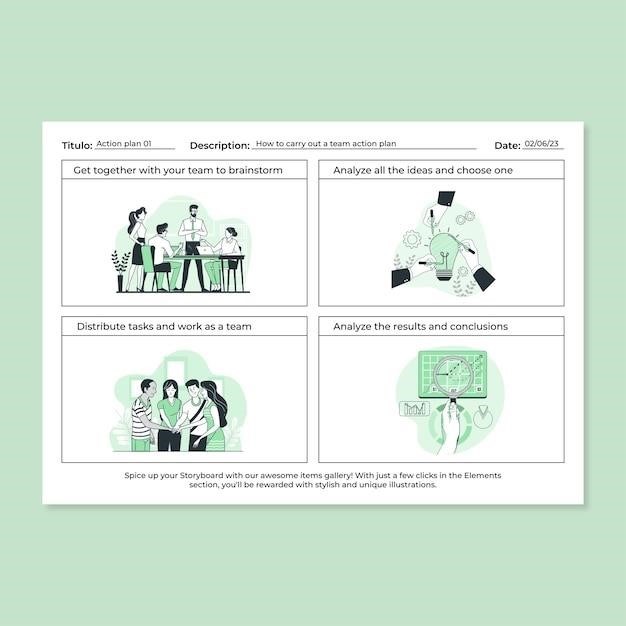
Student Engagement Strategies⁚ A Comprehensive Guide
This guide explores effective strategies to boost student engagement, covering various approaches from active learning techniques and classroom management to leveraging technology and catering to diverse learning styles. We examine the impact of engagement on learning outcomes and offer practical methods for creating a positive and supportive learning environment. Discover how to measure and evaluate the effectiveness of your chosen strategies.
Student engagement is a multifaceted concept encompassing a student’s cognitive, behavioral, and emotional investment in learning. It’s not merely about physical presence in the classroom but a deep-seated involvement in the learning process. Cognitively engaged students actively process information, ask questions, and critically analyze concepts. Behaviorally, they participate actively in class discussions, complete assignments diligently, and seek opportunities to extend their learning. Emotionally, they demonstrate enthusiasm, persistence, and a sense of belonging in the learning community. Understanding these diverse aspects of engagement is crucial for educators seeking to create effective learning environments. A highly engaged student is actively involved, showing both intellectual curiosity and emotional investment in the learning experience. This holistic definition guides the development of strategies designed to foster a deeper connection between students and their learning. Measuring engagement requires observing both overt behaviors and assessing underlying attitudes and motivations. The goal is to cultivate a learning environment where students are not just present but actively participating and thriving.
The Importance of Student Engagement⁚ Impact on Learning Outcomes
Student engagement significantly impacts academic achievement and overall learning outcomes. Highly engaged students demonstrate improved academic performance, achieving higher grades and test scores. This is because engagement fosters deeper learning, enabling students to retain information more effectively and apply it to new situations. Furthermore, engaged students are more likely to persist in their studies, showing greater resilience in the face of challenges. They develop stronger problem-solving skills and a greater capacity for critical thinking. The positive correlation between engagement and academic success is well-documented, highlighting the importance of creating engaging learning environments. Beyond academics, engaged students develop crucial life skills, including collaboration, communication, and self-advocacy. They are more likely to develop a lifelong love of learning, fostering their personal and professional growth. Investing in strategies that enhance student engagement is therefore an investment in their future success.
Types of Student Engagement⁚ Cognitive, Behavioral, and Emotional
Student engagement encompasses three interconnected dimensions⁚ cognitive, behavioral, and emotional. Cognitive engagement reflects a student’s intellectual investment in learning. This includes active participation in class discussions, critical thinking, problem-solving, and a genuine desire to understand complex concepts. Behaviorally engaged students actively participate in classroom activities, complete assignments on time, and seek opportunities to extend their learning beyond the classroom. Their actions demonstrate a commitment to their education. Emotional engagement involves students’ feelings and attitudes towards learning. Emotionally engaged students feel a sense of belonging in the classroom, express enthusiasm for learning, and demonstrate resilience in the face of academic challenges. They are motivated and invested in their educational journey. These three dimensions are interwoven and mutually reinforcing. A student who is cognitively engaged is more likely to be behaviorally and emotionally engaged, and vice versa. A comprehensive approach to enhancing student engagement must address all three aspects.
Strategies for Enhancing Cognitive Engagement⁚ Active Learning Techniques
Active learning techniques are crucial for boosting cognitive engagement. Instead of passive listening, these methods actively involve students in the learning process. Think-Pair-Share, a simple yet effective strategy, encourages students to reflect individually, discuss ideas with a partner, and then share their conclusions with the larger group. This fosters collaboration and deeper understanding. Another powerful technique is problem-based learning (PBL), where students work collaboratively to solve real-world problems. This approach challenges students to apply their knowledge and develop critical thinking skills. Incorporating case studies, simulations, and role-playing can also significantly enhance cognitive engagement. These interactive methods make learning more relevant and engaging, moving away from rote memorization towards a deeper, more meaningful understanding of the subject matter. Regularly incorporating these active learning strategies helps to cultivate a more intellectually stimulating and rewarding learning experience for students.
Promoting Behavioral Engagement⁚ Classroom Management and Structure
Effective classroom management is paramount to fostering behavioral engagement. A well-structured learning environment provides a sense of order and predictability, reducing disruptive behaviors and increasing student focus. Clear expectations and rules, co-created with students whenever possible, promote a sense of ownership and responsibility. Consistent and fair enforcement of these rules is vital. Using positive reinforcement techniques, such as praising positive behaviors and offering rewards for good work, encourages desired actions. Providing choices within the learning activities can also enhance engagement by allowing students some autonomy. A flexible seating arrangement, where appropriate, can cater to different learning styles and preferences. Strategies like incorporating movement breaks and varying instructional methods help maintain student attention and prevent restlessness. By creating a supportive and respectful classroom climate, teachers can foster a sense of community and belonging, contributing to improved behavioral engagement and a more productive learning environment. Addressing disruptive behaviors promptly and fairly, focusing on restorative practices rather than punitive measures, helps maintain a positive learning atmosphere.

Boosting Emotional Engagement⁚ Creating a Positive and Supportive Learning Environment
Emotional engagement is crucial for successful learning. A positive and supportive classroom environment fosters a sense of belonging and safety, allowing students to feel comfortable taking risks and participating actively. Building strong teacher-student relationships is key; showing genuine care and interest in students’ well-being creates trust and encourages open communication. Incorporating opportunities for students to express themselves creatively, whether through writing, art, music, or drama, can tap into their emotional intelligence and enhance engagement. Celebrating student successes, both big and small, boosts confidence and motivates further effort. Providing regular opportunities for positive social interaction among students through collaborative projects and group work strengthens their sense of community and belonging. Creating a classroom culture that values effort and perseverance over solely achieving high grades helps students feel less pressure and more motivated to learn. Addressing students’ emotional needs with empathy and understanding creates a safe space for them to learn and grow. By fostering a positive emotional climate, teachers can significantly improve students’ overall engagement and well-being in the learning process.
Utilizing Technology for Engagement⁚ Educational Apps and Platforms
Educational technology offers powerful tools to boost student engagement. Interactive simulations, educational games, and virtual field trips can make learning more fun and accessible. Learning management systems (LMS) provide a centralized platform for distributing materials, assignments, and feedback, enhancing communication and organization. Utilizing educational apps tailored to specific subjects or learning styles can cater to individual student needs and preferences. Multimedia resources like videos, podcasts, and interactive presentations can cater to diverse learning styles and keep students actively involved. Communication tools like online forums and collaborative platforms foster peer interaction and knowledge sharing. However, it’s crucial to use technology thoughtfully and avoid overwhelming students with excessive screen time. Integrating technology strategically and purposefully, focusing on enhancing learning experiences rather than simply replacing traditional methods, is key. Providing opportunities for students to create digital content, such as presentations or videos, can empower them and encourage active learning. The effective integration of technology requires careful planning and consideration of accessibility and digital literacy needs.
The Role of Assessment in Engagement⁚ Feedback and Formative Assessment
Assessment plays a crucial role in fostering student engagement. Formative assessments, such as quizzes, exit tickets, and in-class activities, provide regular feedback and identify areas where students need additional support. This timely feedback allows for adjustments in teaching strategies and ensures students remain on track. Providing constructive criticism, focusing on both strengths and areas for improvement, is essential for fostering a growth mindset. Using a variety of assessment methods, including projects, presentations, and essays, caters to different learning styles and keeps students interested. Student self-assessment, where students reflect on their own learning and identify areas for improvement, promotes metacognition and encourages ownership of their learning journey. Regularly checking for understanding, through informal methods like quick polls or thumbs-up/thumbs-down checks, keeps students involved and allows teachers to address misconceptions promptly. Summative assessments, while important for evaluating overall learning, should also be designed to engage students and provide meaningful feedback. The emphasis should be on learning and growth, rather than solely on grades. Creating a safe and supportive environment where students feel comfortable taking risks and sharing their work is paramount for effective assessment practices that foster engagement.
Incorporating Real-World Applications⁚ Connecting Learning to Students’ Lives
To significantly boost student engagement, connect classroom learning to students’ daily lives and future aspirations. This can be achieved by incorporating real-world projects, case studies, and simulations that mimic real-life situations. For instance, a math class could tackle a budgeting project, while a science class could design an experiment related to environmental issues. Engaging students in community-based projects allows them to apply their knowledge to solve real-world problems, fostering a sense of purpose and relevance. Guest speakers from various professions can provide insights into how specific subjects are applied in the workplace, inspiring students and broadening their perspectives. Field trips, internships, and job shadowing offer firsthand experiences that make learning tangible and memorable. Encouraging students to research and present on topics that interest them, connecting their passions to classroom material, can also be highly effective. By bridging the gap between academic learning and practical application, educators can cultivate a deeper understanding and appreciation for the subject matter, thereby enhancing student engagement and motivation. Showcasing the practical value of education strengthens student investment and demonstrates the real-world applicability of their studies.
Strategies for Diverse Learners⁚ Catering to Individual Needs and Learning Styles
Effective teaching acknowledges the diverse learning styles and needs within a classroom. To foster inclusivity and maximize engagement for all students, educators should employ differentiated instruction. This involves providing varied learning materials and activities catering to different learning preferences – visual, auditory, kinesthetic, or a combination. Offering choices in assignments allows students to select tasks aligned with their strengths and interests, promoting ownership and motivation. Providing varied levels of support ensures that students receive the appropriate assistance to succeed; This might involve pre-teaching key concepts for some students or offering extension activities for advanced learners. Regularly assessing student understanding and adjusting teaching strategies based on their progress is crucial. Utilizing a variety of assessment methods – including projects, presentations, and discussions – allows for a comprehensive evaluation of learning. Incorporating technology can also cater to diverse learning styles. Interactive simulations, educational apps, and multimedia resources provide engaging learning experiences. Remember to create a supportive and inclusive classroom environment where students feel comfortable asking questions and seeking help. By acknowledging and accommodating individual differences, educators can create a more engaging and equitable learning environment for all students.
Collaboration and Group Work⁚ Fostering Peer Learning and Interaction
Collaborative learning, through well-structured group work, significantly enhances student engagement. Group activities foster peer interaction, encouraging students to actively participate in discussions and problem-solving. The collaborative nature of group projects promotes a sense of shared responsibility and accountability, motivating students to contribute meaningfully. When designing group tasks, it’s crucial to establish clear roles and expectations for each member, ensuring equitable participation and preventing any single student from dominating. Providing a framework for collaboration, such as a rubric or guidelines for group discussions, helps students navigate the group dynamic effectively. Regular check-ins and monitoring of group progress allow teachers to provide timely support and address any challenges that might arise. The opportunity to learn from peers, share ideas, and receive constructive feedback from classmates can significantly enhance a student’s understanding of the subject matter. Furthermore, group work can develop valuable interpersonal skills, including communication, negotiation, and conflict resolution. By carefully planning and facilitating group activities, educators can create a dynamic and engaging learning experience that leverages the power of peer interaction to boost student understanding and motivation. Remember to consider individual learning styles when forming groups and choose activities that promote both individual and collective contributions.
Effective Questioning Techniques⁚ Stimulating Critical Thinking and Discussion
Strategic questioning is paramount for stimulating critical thinking and fostering engaging classroom discussions. Move beyond simple recall questions; instead, utilize open-ended questions that encourage students to analyze, synthesize, and evaluate information. These higher-order thinking questions prompt deeper engagement and necessitate more thoughtful responses. Incorporate “think-pair-share” activities, where students individually ponder a question, discuss their ideas with a partner, and then share their conclusions with the larger group. This approach encourages active participation and builds confidence in sharing ideas. Vary your questioning techniques; use probing questions to delve deeper into student responses and encourage further exploration of the topic. Don’t hesitate to redirect or rephrase questions to ensure clarity and understanding. Wait time is critical; allow ample time for students to formulate their answers. Avoid interrupting or immediately responding to the first answer received, creating space for more diverse perspectives to emerge. Encourage students to ask their own questions, fostering a sense of ownership and curiosity. This active participation strengthens their understanding and promotes a more interactive learning environment. Remember that effective questioning is not just about the questions themselves, but also the way they are posed and the environment in which they’re asked. Create a safe and respectful space for students to share their thoughts, even if those thoughts are unconventional or incomplete. This fosters a culture of intellectual risk-taking and helps students develop their critical thinking skills.
Measuring and Evaluating Engagement⁚ Assessing the Effectiveness of Strategies
Measuring student engagement requires a multifaceted approach that goes beyond simple observation. Regularly assess the effectiveness of your implemented strategies using a combination of quantitative and qualitative data. Quantitative measures might include attendance rates, participation in class activities, and scores on assessments. However, these alone don’t fully capture the depth of engagement. Qualitative data offers crucial insights. Incorporate student feedback through surveys, interviews, or focus groups to understand their perceptions of the learning environment and the effectiveness of various teaching strategies. Observe student behavior during lessons, noting their level of active participation, focus, and enthusiasm. Analyze the quality of their contributions during class discussions and group work. Do their responses demonstrate critical thinking and a genuine interest in the subject matter? Consider using technology to gather data. Online platforms and learning management systems can track student activity, such as time spent on assignments, frequency of forum participation, and completion rates. By combining quantitative and qualitative data, you gain a comprehensive understanding of student engagement levels. This data-driven approach enables you to refine your strategies, ensuring your teaching methods resonate with students and foster a dynamic and engaging learning environment. Remember to adapt your assessment methods to the specific context of your classroom and student population. Regular evaluation is crucial for continuous improvement, allowing you to refine your approach and maximize student engagement.
